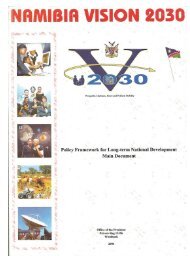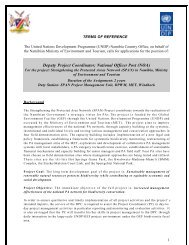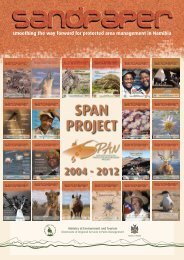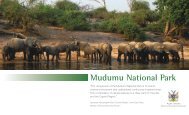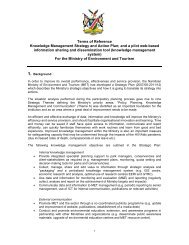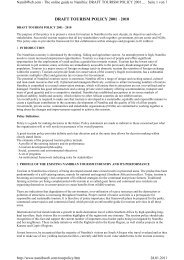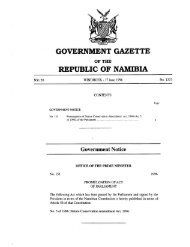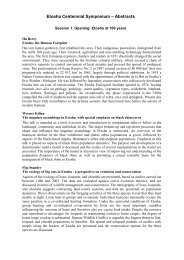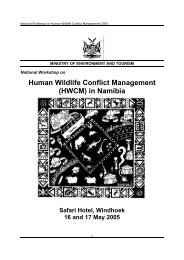EXECUTIVE SUMMARY - Ministry of Environment and Tourism
EXECUTIVE SUMMARY - Ministry of Environment and Tourism
EXECUTIVE SUMMARY - Ministry of Environment and Tourism
Create successful ePaper yourself
Turn your PDF publications into a flip-book with our unique Google optimized e-Paper software.
14<br />
the oshanas <strong>of</strong> the Cuvelai drainage, Okavango River <strong>and</strong> Zambezi catchment. However, it is<br />
believed that there has been a gradual decline in fish stocks due to:<br />
• poor catchment management;<br />
• reduction in number, size <strong>and</strong> duration <strong>of</strong> floods;<br />
• replacement <strong>of</strong> traditional fishing methods with modern tackle <strong>and</strong> fine gill nets;<br />
• destruction <strong>of</strong> riverine vegetation;<br />
• overfishing;<br />
• erosion <strong>of</strong> traditional authority over fishing rights;<br />
• changes in channel morphology;<br />
• inadequate government resources to ensure proper fisheries management <strong>and</strong> control.<br />
Legal Trade<br />
Legal trade in species is not a major activity at present, except for the recent burgeoning <strong>of</strong> Devil’s<br />
Claw harvesting <strong>and</strong> the export <strong>of</strong> materials derived from the annual seal culling operations.<br />
However, most exported material is in the “raw”, unprocessed form such as hides <strong>and</strong> skins, dry plant<br />
parts, tusks etc. with very little added value for the Namibian economy. This results in two things:<br />
the lack <strong>of</strong> appreciation by the rural communities <strong>of</strong> the value <strong>of</strong> the products exported <strong>and</strong> the<br />
reduced potential to earn significant foreign exchange.<br />
Flora. Trade in live plants is limited. Most <strong>of</strong> the imported species are Cycads, while the majority <strong>of</strong><br />
live exports comprise Aloes <strong>and</strong> Euphorbias, with a few Cycads.<br />
A large-scale commercial export trade has developed around two species <strong>of</strong> indigenous plants,<br />
Harpagophytum procumbens (known as Devil’s Claw) <strong>and</strong> H. zeyheri, which are used to treat<br />
rheumatism <strong>and</strong> arthritis-type ailments. Several hundred tonnes <strong>of</strong> dry material <strong>of</strong> these species,<br />
worth millions <strong>of</strong> Namibian dollars, are exported annually.<br />
Mammals <strong>and</strong> Mammal Products. Mammals <strong>and</strong> mammal products play a major role in the legal<br />
trade <strong>of</strong> wildlife, <strong>and</strong> they are exported in large numbers. Most <strong>of</strong> the mammal product exports are<br />
in the form <strong>of</strong> raw or tanned skins. Exports can also be in the form <strong>of</strong> skulls, trophy parts, live<br />
animals, dead animals (mainly stuffed hunting trophies) skin pieces, horns, elephant tusks, teeth etc.<br />
Approximately 100 000 large mammals are removed from wild populations per annum, <strong>of</strong> which 6-<br />
10% are exported live, 6-10% are trophy hunted <strong>and</strong> the majority (80-88%) are hunted for own use.<br />
The most commonly captured species are blue wildebeest, el<strong>and</strong>, hartebeest, kudu, oryx <strong>and</strong><br />
springbok. Live imports mostly comprise black <strong>and</strong> blue wildebeest, blesbok, common impala,<br />
springbok <strong>and</strong> waterbuck.<br />
Birds. Most <strong>of</strong> the legal trade in birds is <strong>of</strong> captive-bred parrots, lovebirds <strong>and</strong> parakeets. The export<br />
trade is limited in terms <strong>of</strong> numbers <strong>of</strong> species, but increasing.<br />
Reptiles. Most <strong>of</strong> the trade in reptiles comprises export <strong>of</strong> live crocodiles.<br />
Pressures on Sustainable Harvesting<br />
There are a number <strong>of</strong> pressures which may affect the sustainability <strong>of</strong> harvesting for subsistence<br />
purposes:<br />
L<strong>and</strong> Tenure. The current system <strong>of</strong> l<strong>and</strong> tenure in Namibia does not favour those who live in<br />
communal l<strong>and</strong>s, because there is no interest in preserving resources because they are common to all.<br />
W423: SOER on Parks, <strong>Tourism</strong> & Biodiversity: Executive Summary July 2000 14



